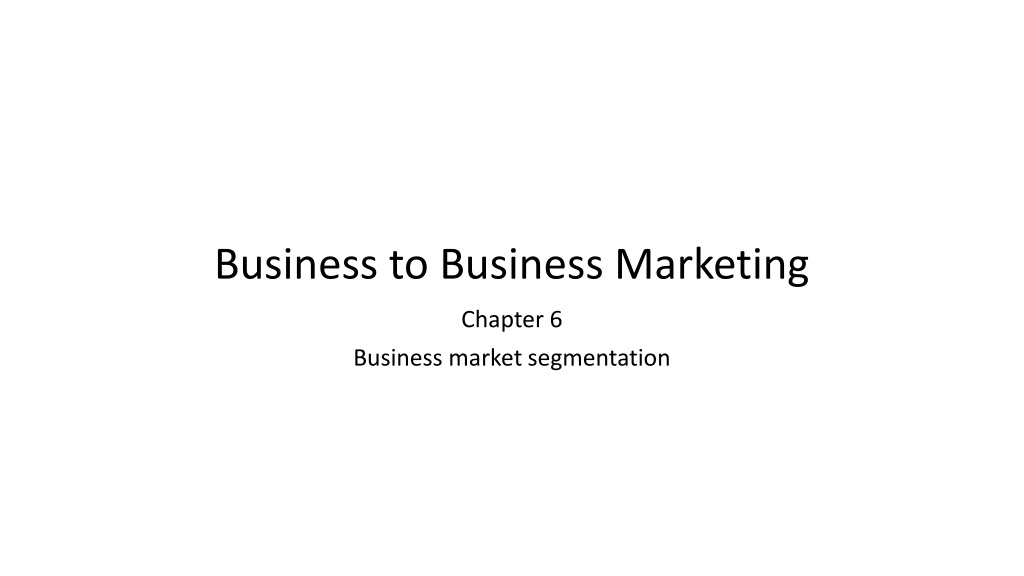

Replay
0 likes | 10 Views
Efficient and effective solutions to customer problems in business marketing are achieved through segmentation, enabling targeted approaches for sustainable relationships. Firmographics, operating variables, situational factors, and personal characteristics play key roles in market segmentation. Understanding buyer personas, such as transformational leader Tony, helps navigate the challenges of B2B segmentation and development of offerings in a less homogeneous customer environment.

E N D
Business to Business Marketing Chapter 6 Business market segmentation
Segmentation and targeting • Segmentation • provides marketer with basis to achieve efficient and effective solution to customer problems, by • establishing degrees of homogeneity in otherwise heterogeneous market place . • Homogeneous groups resulting from segmentation process • enable marketer to decide what parts of market to target with its solutions • targeted in expectation that it can solve customer problems more effectively and profitably than competitors
Segmentation and relationships Segmentation enables best match between problem-solving abilities and uncertainties of both buyer and seller so that sustainable relationships can be created.
Figure 6.1 The segmentation funnel Firmographics Operating variables Purchasing approach Situational factors Personal characteristics (adapted from Shapiro and Bonoma, 1984)
Firmographics ‘Business market ‘demographics’ • segmentation by industry sector e.g. the plastics industry is a different segment from the pharmaceutical industry • segmentation by organisation size e.g. retailers with over 100 outlets are a different segment from single-outlet shopkeepers • segmentation by location e.g. farmers in East Anglia are a different segment from farmers in Wales
Figure 6.2 Using firmographics Segment Industry: company activity NAICS Code 327120 companies worldwide 178,34 Category Clay building material and refractories manufacturing Segment Industry Company size: turnover companies worldwide ≥ $50m turnover 374 NAICS Code 327120 ≥ $50m Segment Industry Turnover Location countries ≥16 companies ≥ $50m turnover 7 NAICS Code 327120 ≥ $50m Countries ≥16 companies Country Number of companies Italy Brazil Japan China Spain Germany USA 39 33 33 32 22 20 16 Country Name of company Brazil Magnesita Refratorios SA PGB S.A. Pyrotek Tecnologia LTDA Gressit Revestimentos Industria E Comercio LTDA Casagrande Revstimentos Ceramicos S/A Derived from data available at Orbisbvdinfo.com
Operating variables • company technology • product and brand-use status • customer capabilities • customer strategic type: prospector, defender, analyser, reactor
Organizational purchasing approach • purchasing function organization • power structures • buyer–seller relationships • general purchasing policies • purchasing criteria
Situational factors in segmentation driven largely by time and scale-dependent variation. includes: • urgency of customer need • scale of need
Personal characteristics of buyers over and above organizational structures, policies & processes • buyer motivation • buyer risk management behaviour • relationship style • similarity of world view to supplier requires sufficient access to customer to use well
Figure 6.3 Buyer persona Tony the transformational leader • • • • IT director technical decision maker develops IT strategy and plan leads technology evaluationteams Background 45+ yearsold; first degree; Executive MBA; 10+ yearsexperience in company-wide senior management roles Mindset leader; strong business acumen; prudent with budgets; not easily convinced by buisness marketerclaims Reputation innovative; focused; respected by industry peers Core purpose enable company-wide transformation;shift view of technology for functional to strategic role Practice leadership: comprehensive approach to interpreting and presenting things expertise: broadIT knowledge rather than technical details innovation: follows latest trends; draws from evidence-based application of new technologies expectations: demandingof IT team and vendors/solutions to enable strategy implementation Frustrations finding technology that offers best potental securing company-wide acceptance for new software initiatives identifying ways to make measurable impact Anxieties making poor purchase decisions; tarnishing reputation Key irritations ill-preparedsales people focused on their own targets rather than his needs; withdrawalof sales rep contant and support once technology solutions are in place Internal influencers finance director; managing director; board of directors Drivers bonus; personal ego; peer recognition Search behaviour keywords: sources: content preferences: enterprisesoftware ROI; strategic software investments; illiminating functional silos; increasing firm productivity peers; online searches; Gartner; Director Magazine in-depth white papers; podcasts
Challenges of B2B segmentation customers less homogeneous; this compounded further by their visibility and interaction with suppliers customer interaction with suppliers complicates stimulus-response approaches used by marketer so that it’s less obvious as to when an outcome is the result of a specific approach interaction can cut both ways i.e. business customers often very active in communicating their needs to suppliers directly
Challenges of B2B segmentation development of offerings is typically more complex and often developed in conjunction with customers interactions with customers are often via a variety of channels evolution of market structure, competition, technology and product, leads to marked changes in segments
Set up for effective segmentation? Y/N Adequacy of infrastructure to support segmentation: 1. Is management committed to the process? 2. Are lines of communication open throughout the organization? 3. Do you have a management information system (MIS) in place for gathering marketing intelligence? Adequacy of processes for undertaking the segmentation: 4. Do you have sufficient marketing data and internal consensus for logically grouping market subsets? 5. Does the chosen segmentation scheme fit the organization’s mission and strategic planning initiatives? 6. Do you have managerial support to provide appropriate personnel and adequate finances for the segmentation initiative?
Set up for effective segmentation? Y/N Adequacy of basis of response to segmentation operations and implementation: 7. Is communications strategy in place for informing both internal and external constituencies? 8. Are the right people in place and committed to operationalizing the segmentation scheme? 9. Has management shown long-term commitment to segmentation rollout and monitoring? If answer to the 9 questions is generally ‘No’ then basis for effective segmentation isn’t there Weinstein, A. (2006) “A strategic framework for defining and segmenting markets”, Journal of Strategic Marketing, 14(2), 115-27.
Segments and differentiation • companies that engage in an undifferentiated targeting strategy make essentially the same offer to all segments • differentiated target market selection involves choosing a variety of different segments and providing offerings that are focused on meeting the needs of those targets more specifically
Figure 6.4 Step-wise segment selection process (adapted from Freytag & Clarke, 2001)